

Understanding Workplace Values - Importance of Culture Fit From MindTools.com. © iStockphotodblight Make your team's cultural values shine.
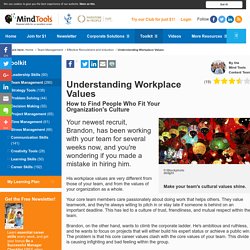
Your newest recruit, Brandon, has been working with your team for several weeks now, and you're wondering if you made a mistake in hiring him. His workplace values are very different from those of your team, and from the values of your organization as a whole. Your core team members care passionately about doing work that helps others. They value teamwork, and they're always willing to pitch in or stay late if someone is behind on an important deadline. Brandon, on the other hand, wants to climb the corporate ladder. To Lead Across Cultures, Focus on Hierarchy and Decision Making. Executive Summary When misunderstandings arise among members of global teams, it’s often because managers conflate attitudes toward authority and attitudes toward decision-making.

However, the two are different dimensions of leadership culture, says the author, who has extensive research and consulting experience with global companies. 9 best questions to ask an EE job candidate. Dan Ariely: What makes us feel good about our work? Treat Employees Like Business Owners.
Employee loyalty and engagement are hot topics, and for good reason.
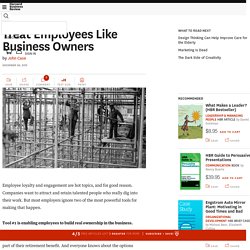
Companies want to attract and retain talented people who really dig into their work. But most employers ignore two of the most powerful tools for making that happen. Tool #1 is enabling employees to build real ownership in the business. Of course, many public corporations offer stock-purchase plans or the like as part of their retirement benefit. And everyone knows about the options collected by a select few in Silicon Valley and other tech centers. It doesn’t have to be. Just look at the supermarket industry to see such ownership in action. You don’t think that kind of generosity builds commitment and passion? Tool #2 goes by different names: open-book management, economic transparency, ownership culture. If you work for a conventional organization, your job is to show up at the appointed time and perform certain tasks.
The approach is easiest to understand in a small company. Empowered Employee Teams. As many organizations begin restructuring their corporate cultures with empowered employee teams, employees across the organization will be involved in the decision-making process.
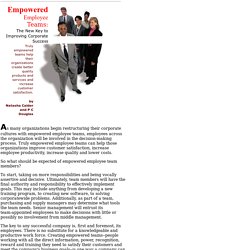
How to Create an Open Organization - HBR Video. The Bossless Organization: From Bosses to Mentor Investors. Some of the organizational symptoms are unengaged and passive employees, high turnover, a lack of innovation, and high inertia against change and adaptation.
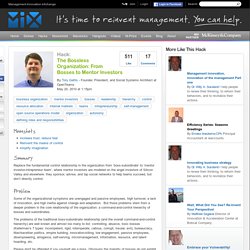
But those problems stem from a deeper problem in the core relationship of the organization: a command-and-control hierarchy of bosses and subordinates. The problems of the traditional boss-subordinate relationship (and the overall command-and-control hierarchy) are well known and almost too many to list: controlling, abusive, toxic bosses (Kellerman’s 7 types: incompetent, rigid, intemperate, callous, corrupt, insular, evil), bureaucracy, Machiavellian politics, empire building, innovation-killing, low engagement, passive employees, disempowering, arrogance, self-serving, micromanagement, information, resource, and talent hoarding, etc.
Please don't be offended if you yourself are a boss. El futuro del trabajo. Identify Your Thinking Style - HBR Video. Itay Talgam: Lead like the great conductors. Getting to Yes Across Cultures - HBR Video. Motivating people: Getting beyond money. Companies around the world are cutting back their financial-incentive programs, but few have used other ways of inspiring talent.
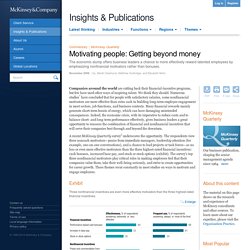
We think they should. Numerous studies have concluded that for people with satisfactory salaries, some nonfinancial motivators are more effective than extra cash in building long-term employee engagement in most sectors, job functions, and business contexts. Many financial rewards mainly generate short-term boosts of energy, which can have damaging unintended consequences. Indeed, the economic crisis, with its imperative to reduce costs and to balance short- and long-term performance effectively, gives business leaders a great opportunity to reassess the combination of financial and nonfinancial incentives that will serve their companies best through and beyond the downturn. Do You Have What It Takes to Help Your Team Be Creative? Competencies testing and training has proved invaluable in business ever since Harvard psychologist David C.
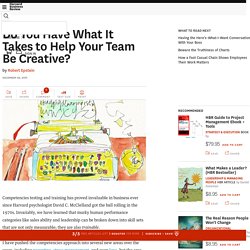
McClelland got the ball rolling in the 1970s. Invariably, we have learned that murky human performance categories like sales ability and leadership can be broken down into skill sets that are not only measurable; they are also trainable. I have pushed the competencies approach into several new areas over the years, including parenting, stress management, and even love, but the area where this approach has had the greatest success has been creativity. In a study I published in 2008, for example, eight months after 173 employees of a small city in California were trained in creativity competencies, managers were still receiving 55% more new ideas than they had been receiving before the training, and city officials attributed $600,000 in new revenues and $3.5 million in innovative revenue reductions specifically to the training. Engaging Your Employees Is Good, but Don’t Stop There. Genius, as Thomas A. Edison famously declared, may be 1% inspiration and 99% perspiration.
But building a company employees truly love reverses the equation: it’s almost all inspiration, and sweat has only a little to do with it. This is the unexpected conclusion of new research from Bain & Company, conducted in conjunction with the Economist Intelligence Unit. Here’s the background. Many commentators talk glibly about employee “engagement,” as if that concept were all-encompassing and easy to define. The foundational elements—call them employee satisfaction—are fundamentals such as having a safe work environment and the tools necessary to do the job. Next come the elements of true engagement, such as the feeling that you’re part of an extraordinary team, that you’re learning and growing, and that you can make a real impact. Most of us know how important inspiration can be in everyday life. In the research, we surveyed over 300 senior executives from companies all over the world.
Interview Ricardo Semler. Ricardo Semler: Radical wisdom for a company, a school, a life. TEDxPugetSound - Simon Sinek - 9/17/09. Daniel Pink on the surprising science of motivation. Interview Questions and Answers.
By Alison Doyle The best way to get ready for a job interview is to take the time to review the most common interview questions you will most likely be asked.
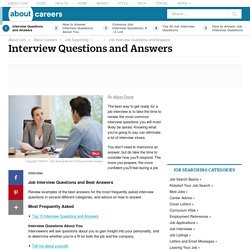
Knowing what you're going to say can eliminate a lot of interview stress. You don't need to memorize an answer, but do take the time to consider how you'll respond. The more you prepare, the more confident you'll feel during a job interview. Job Interview Questions and Best Answers Review examples of the best answers for the most frequently asked interview questions in several different categories, and advice on how to answer. Most Frequently Asked Top 10 Interview Questions and Answers Interview Questions About YouInterviewers will ask questions about you to gain insight into your personality, and to determine whether you're a fit for both the job and the company. continue reading below our video. Ricardo Semler - Leading by Omission.